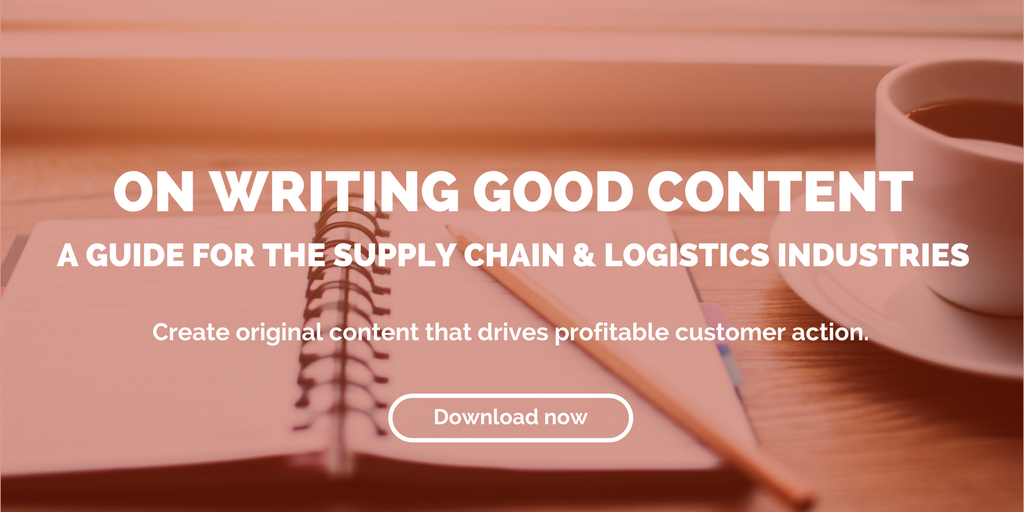
by Fronetics | Jul 16, 2018 | Blog, Content Marketing, Logistics, Marketing, Strategy, Supply Chain
Updated December 11, 2024
Whether you’re selling manufacturing solutions, logistics services, or technology, your supply chain lead generation strategy must address specific industry pain points like inventory optimization, transportation costs, and supplier relationship management.
While content marketing works across industries, supply chain decision-makers have unique needs. Procurement managers, logistics directors, and supply chain VPs face complex challenges:
- Multi-stakeholder buying committees
- Long sales cycles (often 12-18 months)
- High-value purchasing decisions
- Complex technical requirements
- Regulatory compliance concerns
- Integration with existing systems
Let’s explore how to adapt the four core components of lead generation specifically for supply chain audiences.
The 4 Essential Components of Supply Chain Lead Generation
1. Creating High-Value Supply Chain Offers
Supply chain professionals seek concrete solutions to operational challenges. Effective offers include:
Industry Reports:
- Annual logistics cost benchmarking studies
- Regional supplier capability assessments
- Port congestion and capacity forecasts
- Last-mile delivery performance analysis
Technical Resources:
- Warehouse automation ROI calculators
- Transportation management system comparison guides
- Inventory optimization modeling templates
- Supplier risk assessment frameworks
Educational Content:
- Supply chain sustainability certification programs
- LEAN logistics implementation playbooks
- Digital twin technology adoption guides
- Blockchain in supply chain webinar series
2. Supply Chain-Specific Calls-to-Action (CTAs)
Customize your CTAs to resonate with supply chain roles:
For Procurement:
- “Download Supplier Evaluation Template”
- “Access Vendor Management Toolkit”
- “Calculate Potential Sourcing Savings”
For Logistics:
- “Benchmark Your Warehouse Costs”
- “Map Your Distribution Network”
- “Optimize Your Fleet Performance”
For Supply Chain Technology:
- “Compare TMS Features”
- “Schedule WMS Demo”
- “Download Integration Roadmap”
3. Converting Landing Pages for Supply Chain Professionals
Design landing pages that address industry-specific concerns:
Technical Validation:
- Integration capabilities with ERP systems
- API documentation
- Security certifications
- Compliance standards met
Operational Proof:
- Industry-specific case studies (e.g., automotive, retail, pharmaceuticals)
- Performance metrics (e.g., inventory reduction, on-time delivery improvement)
- Implementation timelines
- ROI calculations
Social Proof:
- Logos of recognized supply chain brands
- Industry awards and certifications
- Partnership badges (SAP, Oracle, etc.)
- Client testimonials from supply chain leaders
4. Strategic Form Fields for Supply Chain Lead Qualification
Capture information crucial for supply chain lead scoring:
Company Profile:
- Annual freight spend
- Number of distribution centers
- Current transportation modes
- Manufacturing locations
- System landscape
Project Context:
- Current supply chain challenges
- Priority initiatives
- Decision timeline
- Budget range
- Required integrations
Role Information:
- Position in supply chain organization
- Purchase authority level
- Technology decision-making role
- Geographic responsibility
Supply Chain Lead Nurturing Strategies
Once you’ve captured leads, nurture them with industry-specific content:
Early Stage:
- Educational content about supply chain trends
- Industry benchmark reports
- Thought leadership webinars
Middle Stage:
- Technical specification sheets
- Implementation guides
- Customer success stories
Late Stage:
- Custom ROI analysis
- Pilot program proposals
- Integration assessment reports
Measuring Supply Chain Lead Generation Success
Track these key metrics:
- Lead-to-opportunity conversion by industry vertical
- Sales cycle length for different solution types
- Implementation success rates
- Customer lifetime value by segment
- ROI achieved by solution category
Next Steps in Your Supply Chain Lead Generation Journey
Over the coming weeks, we’ll explore advanced topics including:
- Supply chain buyer persona development
- Industry-specific content strategies
- Technical validation frameworks
- ROI calculation methodologies
Sign up for updates to get these insights and more on generating and nurturing qualified leads in the manufacturing, distribution, and logistics sectors.
Related posts:

by Fronetics | Jul 10, 2018 | Blog, Content Marketing, Logistics, Marketing, Social Media, Strategy, Supply Chain
As with many things, blogs improve with age — drawing more traffic, generating more leads, and building more credibility with search engines.
The average lifespan of a tweet is around 15 minutes. And a Facebook post’s lifespan is about 6 hours. But the lifespan of a blog post averages two years. TWO YEARS.
[bctt tweet=”80% of our website traffic comes from blog posts that are over six months old. HubSpot discovered a similar trend: 76% of its monthly views came from old posts, as well as 92% of the company’s monthly leads!” username=”Fronetics”]
In fact, we find that 80% of our website traffic comes from blog posts that are over six months old. HubSpot discovered a similar trend: 76% of its monthly views came from old posts, as well as 92% of the company’s monthly leads!
Why is that? Because, as with many things, blog posts improve with age. Search engines give value to older content that has had more time to accumulate social shares, likes, and referrals from other web pages. The more relevant a blog post proves itself to be to readers over time, the higher it will rank in search engine results.
Optimizing older content
Blog posts also give marketers an opportunity to dust off older content and rework it to be relevant and up-to-date to target audiences. Using analytics tools, marketers can track posts that had high traffic and conversion rates and work on optimizing the content. Updating older posts with new statistics, relevant keywords, and spruced-up calls-to-action will breathe new life into your older content.
Lead-generation tool: your blog
A blog is an excellent lead-generation tool. But, as I’ve written before, it takes time to generate leads and sales. Patience is a virtue, but it’s a particularly difficult one to keep in mind when you’re trying to grow business and keep your boss happy.
Your posts need time to start drawing traffic — and then, from traffic comes leads. Here’s why blog posts, like a fine wine, will continue to improve with age and why you shouldn’t give up on your efforts.
Video: Why blogs improve with age
Takeaway
With high-quality, relevant content, your blog will pay off. You should keep tending to your already published content, particularly those posts that prove to be a consistent source of traffic.
Update information; add links to new related posts or other relevant resources; and seek opportunities to insert or update calls-to-action to current offers and campaigns. Making sure those older, consistently popular posts continue to serve and engage your readers will increase your chances of conversion.
And, don’t forget: Something that doesn’t get a lot of views in the first week may be a huge traffic source and lead converter in a little time. Many content management systems, like HubSpot, can generate attribution reports, which tell you which web pages users most often visit before converting to a lead. Compare these pages with your high-traffic pages that don’t make the list to see how you can create more opportunities for lead conversion on the pages earning the most traffic.
Related posts:


by Fronetics | Jun 26, 2018 | Blog, Content Marketing, Logistics, Marketing, Strategy, Supply Chain
More and more supply chain marketers are realizing the benefits of inbound marketing (over outbound marketing) including cost savings and increased lead generation.
Marketers are constantly coming up with new and trendy ways to attract leads. With endless platforms available to us, it can be overwhelming for even the most seasoned marketers to know where they need to focus their efforts.
In order to find the right solutions for your supply chain marketing needs, you first have to understand the difference between inbound and outbound marketing. And more importantly, how they can help — or hinder — your marketing efforts.
Outbound marketing
Outbound marketing describes any marketing approach that pushes a message onto a buyer. Traditional marketing — tv and radio ads, telemarketing, banner and display ads — are all examples of outbound marketing.
Another name for this marketing tactic is interruption marketing, as it typically tries to take “attention away from what your buyer is doing and bring it, forcibly, on to your product or service.”
Inbound marketing
Inbound marketing focuses on audiences finding you. Instead of pushing a message onto buyers, inbound marketing allows you to establish your brand as an industry leader and let interested audiences come to you. This type of marketing attempts to draw in potential customers through interesting and engaging content.
Content marketing is a type of inbound marketing. Examples include blog posts, social media, infographics, white papers, and videos.
Why is inbound marketing better for the supply chain?
Outbound marketing used to be the ‘go to’ for generating leads, but this is simply no longer the case. Marketers across industries have found that inbound marketing has many advantages over traditional marketing practices. In fact, almost three-quarters (68%) of inbound organizations believe their marketing strategy is effective, while more than half (52%) of outbound marketers don’t believe their strategy is effective.
[bctt tweet=”Marketers across industries have found that inbound marketing has many advantages over traditional marketing practices. In fact, almost three-quarters (68%) of inbound organizations believe their marketing strategy is effective.” username=”Fronetics”]
Here’s why we think inbound marketing is better for supply chain marketers than outbound marketing.
Video: Why supply chain marketers need inbound marketing
Related posts:


by Elizabeth Hines | Jun 25, 2018 | Blog, Content Marketing, Logistics, Marketing, Social Media, Strategy, Supply Chain
Aiming to deliver value outside the sales funnel allows your business to build long-term relationships with customers, rather than focusing on a single sale.
Congratulations! You closed the deal. You hammered out the terms and set up the billing. But, according to marketing experts Mark Bonchek and Vivek Bapat, now the real work of growing revenue begins.
Successful 21st century businesses focus on what happens after they close a sale, not the transaction itself. That’s because consumers — and B2B customers — have higher expectations than ever before. They read reviews, listen to webinars, and download white papers before they buy, and they expect a better experience after.
Purchase brands vs. usage brands
Bonchek and Bapat describe two types of brands: “purchase brands” and “usage brands.” The usage brands “focus on the moments of truth that happen after the transaction, whether in delivery, service, education or sharing.” As a result, they command greater loyalty and higher prices than competitive brands that are content to end their relationship with an invoice.
[bctt tweet=”Suppliers need to shift focus from persuading people to buy, to persuading them to become a committed advocate for their brand.” username=”Fronetics”]
What does that mean for you as a supplier? You need to shift your focus from persuading people to buy, to persuading them to become a committed advocate for your brand.
“Be” the B2B customer
B2B accounts are complicated. They have many decision makers and many points of contact. You may have a sales team with multiple reps and sales support people on one account.
With so much going on, it’s important to “be” the customer. Try to identify and understand the people who depend on your product or service to get their work done every day. Those are the people you need to impress.
“What is the likelihood that you would recommend Company X to a friend or colleague?” According to Bain & Company, this is the one question that most closely correlates to customer satisfaction. “High scores on this question correlated strongly with repurchases, referrals and other actions that contribute to a company’s growth.”
And what makes people recommend a product or service? Success while they’re using it.
Social media: An important part of the B2B relationship
Bonchek and Bapat say, “The purchase and usage mindsets are equally, or even more, relevant for B2B brands. Business solutions tend to have longer life cycles than consumer products and there is an even greater opportunity to deliver value outside the sales funnel.“
So yes, you may have to tweet. And stay present on LinkedIn. Because your customers look there to follow trends and find good information to help run their businesses. Industry forums, YouTube, and Instagram are also great places to provide value beyond the sale.
Don’t worry if you’re not a creative genius. Most of us aren’t. Do try to talk about issues that are relevant and maybe even unsettling to your industry. If your customers are having a problem, chances are other businesses have the same concerns and vice versa.
You probably have an opinion, maybe even a solution. Use social media to share it with a larger audience, your users will thank you for it.
How do you deliver value outside the sales funnel?
Related posts:


by Elizabeth Hines | Jun 20, 2018 | Blog, Current Events, Leadership, Logistics, Strategy, Supply Chain
Artificial intelligence is forcing change on the supply chain in many ways. But robots, autonomous vehicles, and drones are just part of the equation. Does AI pose a threat to supply chain leadership as well?
A recent Harvard Business Review article explores the idea that “in an AI age characterized by intense disruption and rapid, ambiguous change, we need to rethink the essence of effective leadership. Certain qualities — such as deep domain expertise, decisiveness, authority, and short-term task focus — are losing their cachet, while others, such as humility, adaptability, vision, and constant engagement, are likely to play a key role in more-agile types of leadership.”
Can AI change supply chain leadership as we know it?
What is AI and why does it matter?
Artificial intelligence is coming to your business whether you’re ready for it or not (if it hasn’t already). Why does it matter? Because AI — the ability of machines to carry out tasks in a way we consider “smart” — can boost productivity and profitability.
What AI does “extraordinarily well,” according to consulting firm McKinsey & Co., “is relentlessly chew through any amount of data and every combination of variables.”
[bctt tweet=”Today we’re experiencing a second machine age as computers take on some of our mental workload by making data-driven decisions.” username=”Fronetics”]
Some technologists draw parallels to the Industrial Revolution when machines lightened the load for humans by performing tasks that once required brute strength. Today we’re experiencing a second machine age as computers take on some of our mental workload by making data-driven decisions.
The glass-half-empty crowd is worried that machines will replace humans and take our jobs. But the glass-half-full team sees new opportunities to unburden ourselves from repetitive tasks so we can focus on bigger strategic issues that need the nuanced emotional intelligence only we humans possess.
Traditional vs. AI-ready skills
“At some point in our evolution… leadership acumen transitioned from physical to cognitive skills, putting a premium on intelligence and expertise at the expense of force and strength,” writes HBR article authors Tomas Chamorro-Premuzic, Michael Wade, and Jennifer Jordan.
Offloading repetitive cognitive tasks to machines frees up time to develop new leadership skills. According to the authors, tomorrow’s leaders will be more empathetic, more agile, and more connected to people around them. The authors describe four specific qualities that will define leaders of the future:
Humility
Valuable intelligence won’t be delivered from the top down and may not come from the most experienced people on the team. It will come from every direction. Leaders should be open to suggestions and input from people using data at every level inside and outside the organization.
Adaptability
Changing your mind is a good thing in the age of AI. Learning organizations should expect to revise plans and iterate quickly. Managers should be confident enough to propose a change of course based on new data and not feel the need to defend their decision.
Vision
Operations can feel like shifting sands in an AI environment. An organization that continuously adapts to capitalize on new opportunities can leave employees feeling like they don’t know what they’re supposed to be doing from one day (or minute) to the next. Successful leaders will emphasize long-term goals, encourage questions, and provide clear, thoughtful, consistent answers.
Engagement
Successful leaders will come out of their executive suites and connect with customers, partners, and employees. You can’t wait for reports and meetings when fast-paced data-driven decisions are happening all around you. “Agile leaders need to stay engaged… and find ways to keep their teams engaged, particularly when the going gets rough and the path gets challenging,” according to Chamorro-Premuzic, Wade, and Jordan.
So will AI change supply chain leadership?
Learning and applying new skills won’t come easily for many businesses. Some managers might not be comfortable asking employees to demonstrate humility, adaptability, and vision. These are hard skills to measure and haven’t always been rewarded.
Real digital leadership will require a blend of human and machine learning and a new way of understanding how things get done. Any company stands to gain by adopting these new ideas.
Logistics companies, at the nexus of operations for so many industries, can lead the way into the AI age by modeling new skills and applying them to their own businesses.
Machine-learning expert Jeremy Howard sums it up nicely in a McKinsey & Company report: “There is no organization that shouldn’t be thinking about leveraging these approaches, because either you do — in which case you’ll probably surpass the competition — or somebody else will.”
What ways do you think AI will change supply chain leadership?
Related posts:


by Fronetics | Jun 18, 2018 | Blog, Content Marketing, Logistics, Marketing, Strategy, Supply Chain
Looking for blog post ideas? Try using these resources to create topics that are original, relevant, trendy, and — most of all — relevant to your business.
I’ve said it once — ok, way more than once — but I’ll say it again: The more you blog, the more leads you’ll get.
That’s all very well and good, but what happens when you have no idea what to write about?
As usual, the internet is coming to your rescue. Here are four of our favorite online tools to help you generate blog topic ideas.
4 online tools to generate blog post ideas
1) HubSpot’s Blog Ideas Generator
Remember Mad Libs? Give HubSpot three nouns, and its Blog Ideas Generator will give you blog ideas.
While not exactly a Mad Lib, this tool is a great way to focus on topics where you want to cultivate your authority. It’s an excellent way to generate blog post ideas for a topic cluster, in line with existing pillar content.
2) Alltop
Co-created by legendary business advisor and author Guy Kawasaki, Alltop describes its goal as helping you to answer the question “what’s happening” in topics that pertain to your business.
Essentially, it’s a list of recent posts from the most trusted blogs on each topic. Select your topic, and you’ll get posts relating to that topic from the top blog in each industry. It’s gives you a great “in” on the most important conversations going on among thought leaders in the supply chain — and your goal is to become one of them.
3) Ubersuggest
It may not be the best tool for coming up with actual post titles, but Ubersuggest is a great way to generate general topic ideas for new posts. Enter a word or phrase, and Ubersuggest produces a long list of results containing the word or phrase followed by related phrases.
4) Twitter
[bctt tweet=”Yes, you read that right. Twitter can actually be a great way to generate blog post ideas.” username=”Fronetics”]
Try running a Twitter search using your keyword proceeded by a hashtag (#procurement, for example) to get a list of tweets containing your keyword. Twitter also has the bonus of being likely the most up-to-date conversation you can find on the web.
Do you use any tools to generate blog post ideas?
Related posts:












